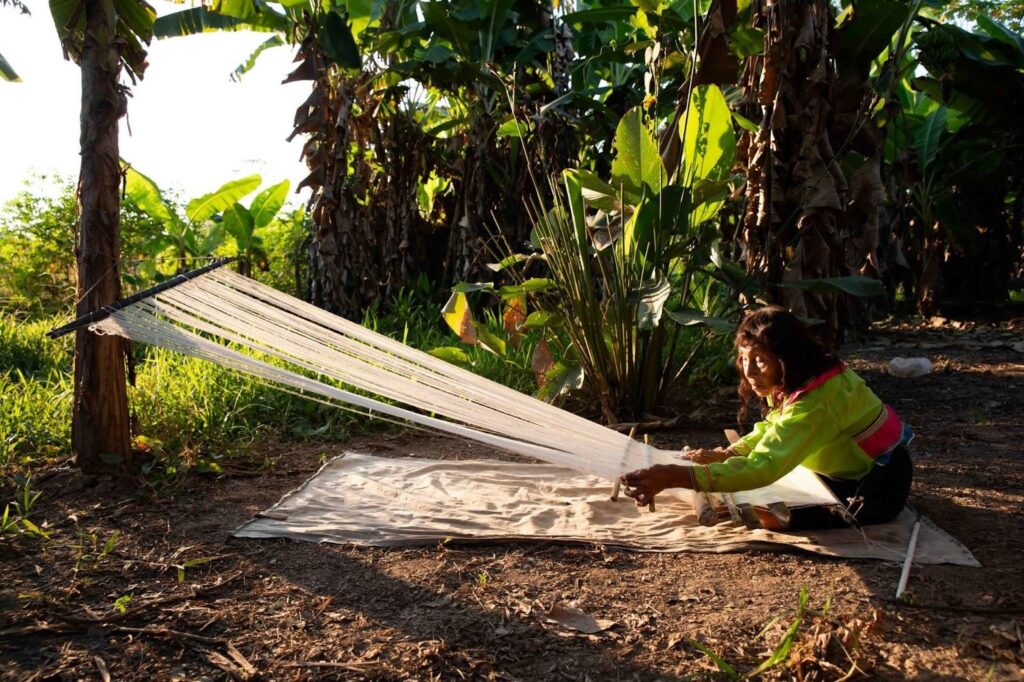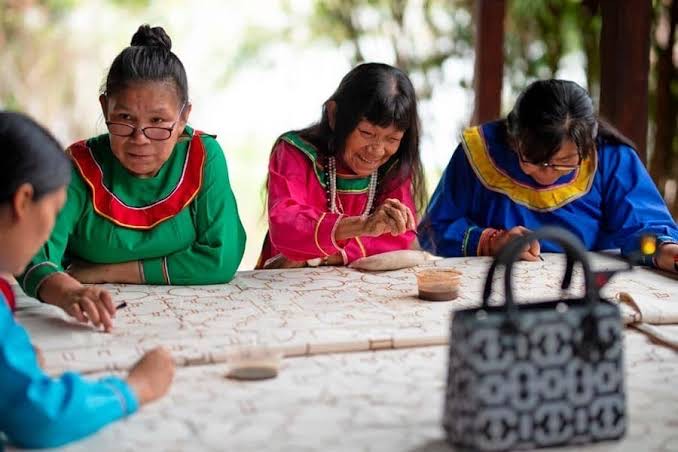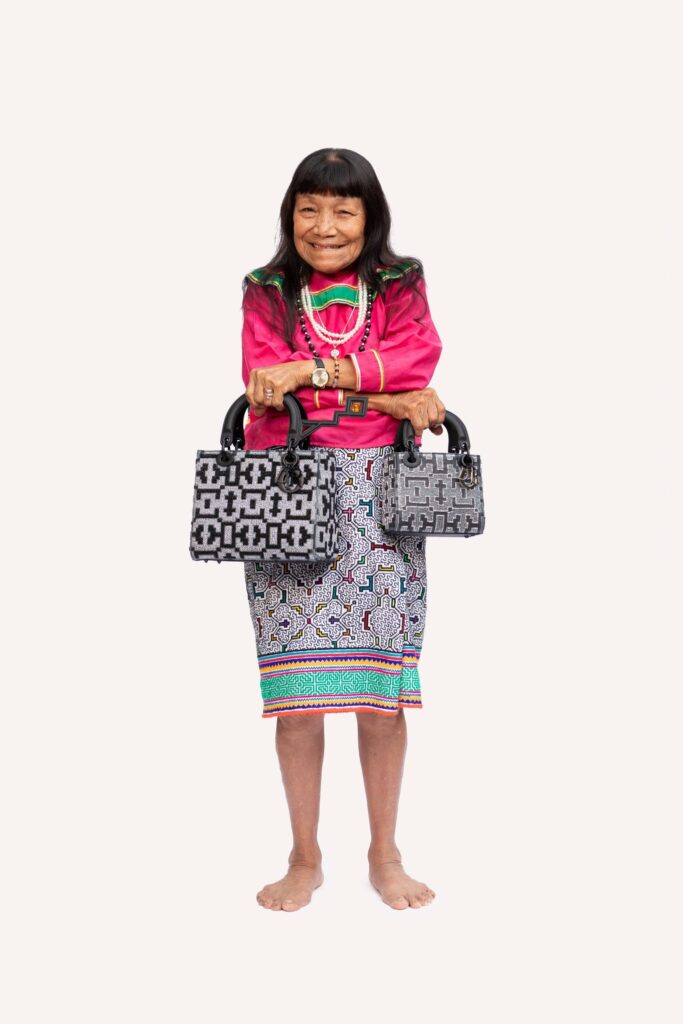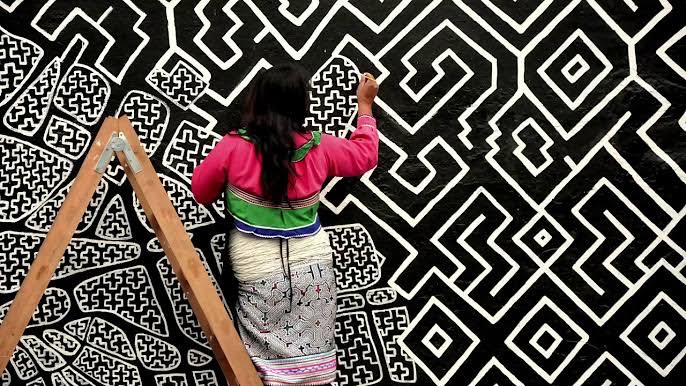
Discovering Kené: The Patterns That Connect Life and Nature
January 17, 2025By María Paz Dakota Ormeño Vasquez, 2024 Future Blue Youth Council member
Cover image by Joinnus Blog – Shipibo Konibo Art Workshop
“Kené”. This four-letter word unlocks a world of complex patterns and vibrant colors. It isn’t just a collection of designs—it’s a visual language that tells stories about nature, history, and life. For the Indigenous Shipibo-Konibo community of the Peruvian Amazon, Kené embodies a worldview that is as fluid and connected as the rivers they live beside. These geometric designs flow with the rhythm of water, mimic the growth of plants, and echo the unseen pathways that connect all living things. It’s more than art—it’s a living bridge between the human world and nature.
The Shipibo-Konibo are one of the largest Indigenous communities in Peru, with a population of approximately 25,000 people, residing primarily along the Ucayali River, Loreto, Madre de Dios, Huánuco, and the Cantagallo area (district of Rímac, city of Lima)6. Their culture is inseparable from “Kené”, a Shipibo-Konibo word meaning “design”, which decorates ceramics, fabrics, tools, and even human bodies1. These designs are often seen in visions inspired by master plants like “Ayahuasca” and the “Chakruna”, which reveal “hidden paths” of nature. In 2008, Peru recognized Kené as part of its national cultural heritage, acknowledging its profound ecological and spiritual significance6.
Kené reflects the interconnectedness of life. Each design has meaning. For example, Mápo Kené, a design with a head shape, symbolizes leadership and strength, representing a guide for the community; Mayá Kené draws from the calm stillness of a lake, signifying unity and harmony; and Xao Kené depicts the merging of opposing forces, showing that balance and coexistence are central to natural equilibrium. These motifs teach us that nature’s balance relies on unity, duality, and change.
There are also “Arched Designs”, which represent the leaves of trees and also arched lines. The “Straight Design” represents trees that are straight, an ancient design. The “Bone Design” represents the bones of fish that pile up when we eat. The “Spider Design” represents the tangle of the spider’s web. The “Flower Design” are small embroideries of different colors that represent bellflowers, and there are many others1.
Kené isn’t static. It’s a living practice that evolves as the Shipibo-Konibo’s environment changes. Unlike art confined to museums, Kené exists in motion. It evolves, just like rivers shift, plants wither and grow, and constellations shift overhead—all part of larger cycles. Each line and pattern captures the Shipibo-Konibo’s understanding of nature’s cycles and relationships. This knowledge is typically passed down through generations of women.
From childhood, girls spend hours each day with their mothers and other female relatives, observing, imitating, and training in the art form1. They are also ritually prepared to develop the gift of visualizing designs in their minds and skillfully translating them into material form. Likewise, they do not use measuring tools, mock-ups, or drafts to create their designs1. For the Shipibo-Konibo, the artist’s mastery is judged by the precision and fluidity of the lines, curves, and angles, the balance of blank spaces, and the integration of these elements into a harmonious and symmetrical whole—often enriched with intentional asymmetry1.
The designs also act as symbolic protection. Shipibo-Konibo healers, known as “Onanya”, use Kené in healing ceremonies. The designs are “sung” into existence through chants, calling upon the natural world’s energy to aid in healing. This practice highlights the deeper purpose of Kené as a force of restoration and protection.
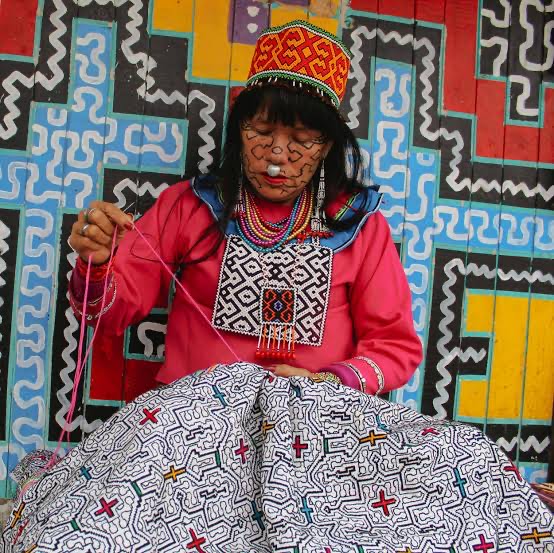
Source: Folk Art Market – Artist Stories
Unfortunately, Indigenous art like Kené faces ongoing threats from cultural appropriation and commodification. A recent example emerged in December 2024 during the “Origins 2024” event organized by the Sustainable Fashion Association of Peru. In a talk at the event, Peruvian designer Anis Samanez and Vogue Mexico and Latin America editor José Forteza expressed indignation over the Amazonian Shipibo-Konibo community’s refusal to share their ancestral textile knowledge for free3. Samanez had planned to commercialize the designs, yet objected to compensating the community for their contributions.
This attitude not only devalues their ancestral knowledge but also perpetuates the exploitation of Indigenous art for profit, offering no financial return to the artists themselves. This is especially problematic considering that the majority of the Shipibo-Konibo live in poverty or extreme poverty7. The Shipibo community in Cantagallo, Lima, for instance, faces additional challenges, including a lack of basic services and precarious living conditions on unstable land, contaminated with high levels of lead and arsenic4. For these communities, fair compensation is essential not just to preserve their cultural heritage, but also to sustain their livelihoods and address their urgent needs.
When these designs are reduced to aesthetic trends, they lose their deeper context as carriers of knowledge. Recognizing the true value of Kené means seeing it not as a fashion statement but as a repository of ancestral wisdom. Supporting Indigenous art becomes a form of environmental activism, as it protects the cultural and ecological knowledge passed down through generations. A noteworthy example is the approach taken by the fashion house “Dior”. In October 2024, Dior introduced a new line of its classic Lady Dior bags featuring motifs inspired by Kené art, designed by Shipibo-Konibo artist Sara Flores. In an official video on the Dior website, Sara shares how this collaboration enables her to support, honor, and preserve her land, her family, and her culture5. By highlighting the artist’s contribution and sharing her work with the world, Dior not only acknowledges the value of Shipibo artistry but also demonstrates how global fashion can celebrate and respect Indigenous heritage.
To conclude, it is important to realize that protecting Kené is a collective responsibility. We must support Indigenous communities, honor their knowledge, and amplify their voices—not just through social media activism, but by actively purchasing their art and products while sharing their beautiful creations with others. The world has much to learn from Kené, and now, more than ever, it’s time to listen.
Citations
- Liogier, C., & Belaunde, L. E. (2009). Kené: arte, ciencia y tradición en diseño.
- Obando, P. M. (2024). De la selva peruana para el mundo: quién es Sara Flores, la artista Shipibo-Conibo que colabora con Dior. Retrieved from https://www.infobae.com/peru/2024/10/17/de-la-selva-peruana-para-el-mundo-quien-es-sara-flores-la-artista-shipibo-conibo-que-colabora-con-dior/
- Campó, P. S. (2024). Caso Anis Samanez: qué es la apropiación cultural y por qué el arte de los shipibo-konibo es patrimonio cultural de la nación. Retrieved from https://www.infobae.com/peru/2024/12/04/caso-anis-samanez-que-es-apropiacion-cultural-y-por-que-el-arte-de-los-shipibo-konibo-es-patrimonio-cultural-de-la-nacion/
- Perú, R. E. C. (2023). Los shipibo-konibo y Cantagallo. Retrieved from https://elcomercio.pe/opinion/columnistas/los-shipibo-konibo-y-cantagallo-por-aldo-facho-dede-noticia/?ref=ecr
- Facebook.com/maria.sarcaantonio. (2024). Sara Flores: El arte kené llega a Dior y transforma la moda con su legado Shipibo-Conibo. Retrieved from https://cosas.pe/moda/325546/sara-flores-el-arte-kene-llega-a-dior-y-transforma-la-moda-con-su-legado-shipibo-conibo/
- Mincul: jornada intercultural acercó a ciudadanía el arte kené, legado ancestral del pueblo indígena u originario Shipibo-Konibo. (n.d.). Retrieved from https://www.gob.pe/institucion/cultura/noticias/1071283-mincul-jornada-intercultural-acerco-a-ciudadania-el-arte-kene-legado-ancestral-del-pueblo-indigena-u-originario-shipibo-konibo
- Los pueblos originarios amazónicos abandonados por el Estado: entrevista a Luzmila Chiricente, dirigente del pueblo ashaninka. (2024). Retrieved from https://idehpucp.pucp.edu.pe/boletin-eventos/los-pueblos-originarios-amazonicos-abandonados-por-el-estado-entrevista-a-luzmila-chiricente-dirigente-del-pueblo-ashaninka-24827/

